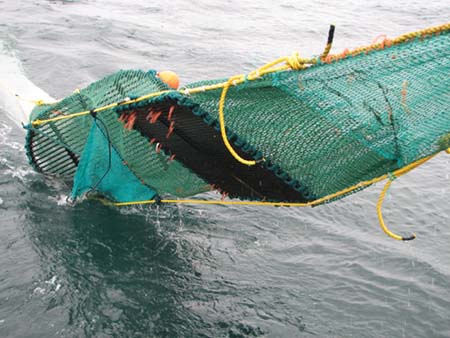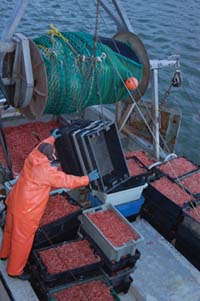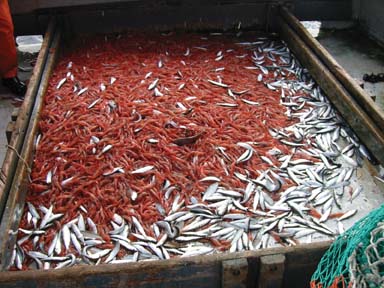 |
 |
| current issue |  | past issues |  | send a letter/news |  | address update |  | advertise |  | about us |  | alumni home |
| Spring 2009 |

|
| Departments |

|
| Alumni News |
| Alumni Profiles |
| Book Reviews |
| Campus Currents |
| Class Notes |
| Features |
| History Page |
| Letters to the Editor |
| Obituaries |
| President's Column |
| Question/Answer |
| University Research |

|
| Department Archives |
| Table of Contents |
|
Search UNH Magazine: |
Features
The Future of FishingPage 3 of 5
 An open-topped net allows small fish to swim away.
An open-topped net allows small fish to swim away.
|
Regardless of which approach she uses, however, the data has been pointing to the same general conclusion. "They swim back and forth across the Atlantic," she says, "to different areas." Her findings support an emerging view that there are more than two stocks.
Lutcavage's further research is aimed at providing a finer scale of detail on the tuna's travels and reproductive habits. Overfishing is just one of many issues to consider. "Since the turn of the century, when people started tracking the climate, we have seen big shifts in bluefin tuna population," she says. "Historic Brazilian and Nordic fisheries have disappeared completely, and what was left of the New England giant bluefin fishery seems to have shifted offshore and north to Canada. Is it really just overfishing, or have shifts in prey and oceanographic conditions changed their distribution? This is an important part of the puzzle."
Pingguo He is explaining what can happen when the creativity of scientists and fishermen meet. On the monitor in front of him is a photo of a plastic tub on the deck of a dragger, full of freshly caught shrimp. "You see?" He says, "there are no fish to sort. The catch is clean." An accomplished photographer, He can make almost anything look good. But what's compelling about this particular image is what's missing.
"Look at the difference." The research associate professor in the Institute for the Study of Earth, Oceans, and Space clicks on another photo: small, dusky herring lie among the shrimp. "fishermen have to sort out these fish," he says, "and throw them back, usually dead."
 
|
| NET RESULT: Pingguo He works with fishermen to reduce the bycatch hauled up by shrimp trawlers. The modified plastic sorting grid allows shrimp too small to sell to escape. A clean catch of market-size shrimp is the result, left. |
Otherwise known as "bycatch," what fishermen throw back includes seabirds, turtles, marine mammals, fish too small or commercially unappealing to be sold, even bottom dwellers like corals and sea cucumbers. Nationwide, the amount of bycatch that gets thrown overboard can add up to 20 percent of the total catch, according to a study co-authored by professor of natural resources Andrew Rosenberg.
Rosenberg has been embroiled in the controversy of fisheries management on both sides of the Atlantic for 25 years. Before coming to UNH, he served on the faculty at London's Imperial College of Science and Technology and later as northeast regional administrator and deputy director in NOAA's National Marine fisheries Service.
"Bycatch undermines our efforts to recover depleted marine resources," says Rosenberg, who calls for legal limits on bycatch. "And it undermines a fisherman's bottom line—removing bycatch is wasted labor." He believes that with the right incentives, fishermen will take advantage of new technology to reduce bycatch.
Pingguo He could not agree more. The son of a Chinese fisherman, he grew up to study fisheries science in the wake of China's cultural revolution. Today, he relies on the entrepreneurial nature of Gulf of Maine fishermen to find creative solutions to reducing bycatch, particularly with shrimp trawlers.
"Shrimp fishing is notorious for bycatch, especially in tropical areas, where for every 10 pounds of catch, there could be nine pounds of bycatch," explains He. The problem is much less severe for coldwater shrimp fisheries like the Gulf of Maine, but even with innovations like the Nordmore grate, a device that keeps larger fish from entering a trawl net, bycatch of small fish and shrimp too small to sell are still a problem, one that He would like to solve with the help of local fishermen and groups like the Northeast Consortium.
Page: < Prev 1 2 3 4 5 Next >Easy to print version